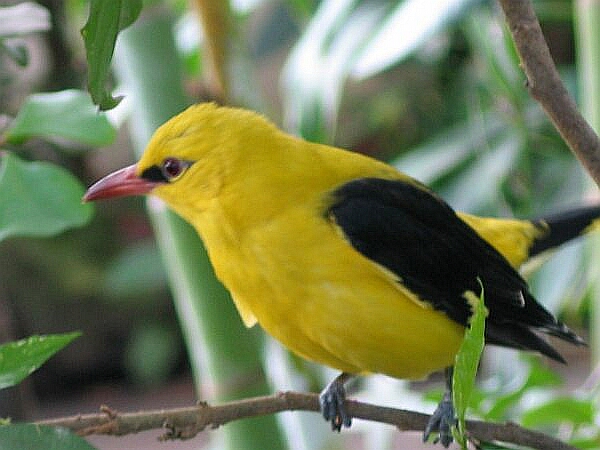- Golden Oriole
Taxobox
name = Golden Oriole
status = LC | status_system = IUCN3.1
status_ref = [IUCN2006|assessors=BirdLife International |year=2004|id=51243|title=Oriolus oriolus|downloaded=12 May 2006 Database entry includes justification for why this species is of least concern]

image_width = 250px
regnum =Animal ia
phylum = Chordata
classis = Aves
ordo =Passeriformes
familia =Oriolidae
genus = "Oriolus "
species = "O. oriolus"
binomial = "Oriolus oriolus"
binomial_authority = (Linnaeus, 1758)The Golden Oriole or European (or Eurasian) Golden Oriole "Oriolus oriolus", is the only member of the
oriole family of passerinebird s to breed in northern hemisphere temperate regions. It is a summer migrant toEurope and westernAsia , wintering in the tropics.It is a bird of tall deciduous trees in woodland, orchards or parks. The tiny British population breeds in commercial
Black poplar plantations, notably at theRSPB Lakenheath Fen nature reserve, where a watchpoint is operated during nesting.The neat nest is built in a fork in a tree, and contains 3-6 eggs. The food is insects and fruit, found in the tree canopies where the orioles spend much of their time.
The male is striking in the typical oriole black and yellow plumage, but the female is a drabber green bird. Orioles are shy, and even the male is remarkably difficult to see in the dappled yellow and green leaves of the canopy.
The flight is somewhat like a thrush, strong and direct with some shallow dips over longer distances.
The call is a screech like a
jay , but the song is a beautiful fluting "weela-wee-ooo" or "or-iii-ole", unmistakable once heard.The name "oriole" was first used in English in the 18th century, and is an application of the scientific Latin genus name, which is ultimately from the Classical Latin "aureolus" golden. Various forms of "oriole" have existed in Romance languages since the 12th and 13th centuries. [OED Online. Accessed 9 Feb 2008]
Albertus Magnus used the Latin form "oriolus" in about1250 , and stated, erroneously, that it was onomatopoeic, from the song of the Golden Oriole.The
New World oriole s are similar in appearance to the Oriolidae, but areicterid s unrelated to the Old World birds.References
External links
* [http://www.ibercajalav.net/img/400_GoldenOrioleOoriolus.pdf Ageing and sexing (PDF) by Javier Blasco-Zumeta]
External links
* [http://ibc.hbw.com/ibc/phtml/especie.phtml?idEspecie=7957 Golden Oriole videos] on the Internet Bird Collection
Gallery
Wikimedia Foundation. 2010.
